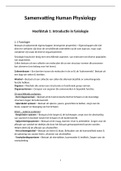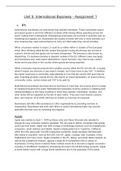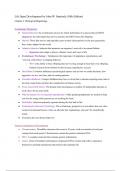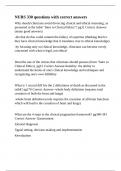Water is assembled with 1 oxygen and 2 hydrogen atoms (H2O) bonded together by sharing
electrons through covalent bonding. H2O is a polar bond which allows hydrogen bonds to form
between molecules to create cohesive forces; cohesion is when molecules are attracted to the same
type of molecule as them. Water can form hydrogen bonds with each other making their cohesive
forces stronger and building stronger interactions with neighbouring molecules at the surface. The
atoms residing in H2O are shown with delta symbols meaning that electrons are not rationed equally
because Oxygen has a higher electronegativity than Hydrogen. This means that Oxygen can easily
attract electrons compared to hydrogen which makes water a polar molecule. H2O is formed with
thousands of loosely bound hydrogen bonds, that are delta + (H), bond with the delta – (O2). This
means that a lot of energy will be needed to raise water by 1° and break its many hydrogen bonds
because of its high specific heat capacity which keeps water at stable temperatures. It’s high specific
heat capacity is important as it makes the ocean an ideal environment for organisms to live in as the
temperature requires a lot of energy to break H bonds and change temperatures.
As a polar molecule, water can also act as a solvent to other polar molecules such as salt; the
chlorine anions are encircled by the partially negative oxygen atoms of water. Simultaneously, the
partially positivity H atoms of the water molecules face and encircle the chlorine anions that are on
the surface of each salt crystal. This results in the anions and cations to break the ionic bonds by
separating.
Water molecules join together using weak hydrogen bonds that can break and form quickly (e.g
water droplets), this is called cohesion, which is the reason behind H2O and it’s fluid consistency. It’s
cohesion with H bonds allows the water molecules to flow as one continuous column of water, this is
called mass flow, an example of this happening is in blood vessels or phloem in the plants. The
polarity of water also allows it to be adhesive, meaning that it can bond with other types of
molecules with positive and negative charges. These two properties cause capillary action; where
the adhesion to the wallah of a vessel is stronger than the cohesive forces between the water
molecules. This allows the water to move against gravity in an upward motion within a vessel and
also allow objects to float above water (e.g, debris due to surface tension).
Water has many important roles in the body such as:
• Electrolyte balance
• Regulate pH
• Regulate Temperature
• Transporting molecules
• Acting as a medium for chemical reactions
Waters’ polar structure allows formation of hydrogen bonds to give water specialised functions and
properties, For example: a high boiling point, high specific heat, cohesion, adhesion and density.
These properties play a part in keeping water in a liquid state over large temperatures around the
body which is useful as a transport medium within cytoplasm of a cell. In addition, temperature and
pH can also be regulated around the body easily. An example of this is the excretion of water out the
body through sweat. This is done by evaporation where lots of energy is needed to break hydrogen
bonds from a liquid into a gas (evaporation) which cools the body effectively by transferring the heat
out of the body. Another function is capillary action which supports the movement of water into and
, out of the cellular structure that stores vita, blood plasma, nutrients and vitamins. This features
supports rehydration and vital communication between the brain and the body.
Carbohydrates
Carbohydrates are made of Monosaccharides- which are simple sugars built up by 3 to 7 carbons
that settle as linear chains or ring-shaped molecules that can be branched or unbranched. Because
monosaccharides are small, they can be respired right away and carried into the bloodstream, or
they can be used to generate other molecules such as lipids, stored (glycogen in liver and muscle
cells), or starch in plants. The structure of Monosaccharides is not suitable for transportin blood and
xylem phloem as it is soluble in water. There are small and can be absorbed in the gut from the
digestive system. It is not a storage molecule and have less influence on a cells osmolarity- therefore
they are bonded together to form disaccharides and polysaccharides through condensation. These
disaccharides and polysaccharides are formed when 2 hydroxyl (-OH) groups bond to create strong
covalent bonds called glycosidic bonds; the oxygen bonds here hold the two molecules together.
Glycosidic bond is a condensation reaction because one water molecule is lost to the surroundings.
Polysaccharides: large, complex molecules that are formed from numerous monosaccharides joined
together by glycosidic bonds. They contain lots of sugars that can be hydrolysed for energy when
required. For plants, starch is an example of a polysaccharide and for animals, glycogen is an










